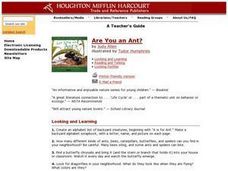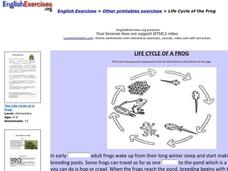Curated OER
Web of Life - Role-Playing
Students role-play how organisms adapt to their environment. They play 20 questions with plant and animal habitats. They create a web of life to demonstrate how each plant and animal relies on the other for survival.
Curated OER
Are You an Ant?
Young scholars investigate different insects in their backyard. In this insect lesson, students read the book Are You and Ant? and apply the reading to their backyards. Young scholars create a list of animals that begin with the the...
Curated OER
Interesting Insects
In this insects worksheet, students read about insects and then answer the 10 questions pertaining to what they just learned. The answers are on the last page.
Curated OER
Insects
Third graders research an insect and creates a brochure on that selected insect. Each student develops a Venn Diagram comparing similarities and differences between moths and butterflies.
Curated OER
"Hey Polliwog!" - The Life Cycle of the Frog
In this life cycle of the frog worksheet, students read and assess comprehension. In this fill in the blank and sequencing worksheet, students write answers to sixteen questions.
Curated OER
A Bug's Life: Diary of an Insect's Metamorphosis
Fifth graders examine the stages of insect's to understand heredity. For this inherited traits lesson, 5th graders explore the life of the honeybee for its inherited traits. Students recognize the difference between inherited traits and...
Curated OER
It's (Not) Just a Bug: Simulating Invasive Insect Predation on a Plant Population
Students reflect on challenges that face farmers in cultivating crops, including insects. They then simulate how crops are affected by native and non-native insect populations and the options farmers have to protect their crops. Finally,...
Curated OER
Invertebrate Vocabulary-- Marine Invertebrate Match
In this science worksheet, students study 12 vocabulary words which pertain to marine invertebrates. Students read the definitions which include pronunciation, part of speech and meaning of the name. Students then look at 16 organisms...
Curated OER
The Spider's Life Cycle
Students see that spiders have a life cycle, and reproduce by laying many eggs. We can count by ones, twos, fives, or as many as we want. They make two lists of animals on a chart.
Curated OER
Marine & Aquatic Habitats Activities - Terrestrial Forests vs. Kelp Forests
Students discuss concept and specificity of habitats, both marine and terrestrial, list similarities and differences in the habitats of a kelp forest and a terrestrial forest, compare types of organisms that occupy corresponding types of...
Curated OER
Interesting Insects
Students discover the characteristics of insects. They explore insects through cooperative learning, group projects, hands on activities, and poetry. They gain knowledge of insect life cycles, habitat, and physical characteristics.
Curated OER
The Insect world
Students read about insects in pairs and answer questions based on their reading. For this insect lesson, students understand the parts of an insect and complete a worksheet. Students complete a list of insects letters a-z.
Curated OER
Life Cycles
Using computers, Students work in small groups and progress through the roles of Explorer, Researcher, Designer, and Evaluator as they study the life cycle of plants, insects, butterflies and frogs.
Curated OER
Unit 21 Terrariums
The history of terrariums and how to construct one are presented in this PowerPoint. Each important step aspect of terrarium care is discussed: selecting a container, drainage, soil, types of plants, and maintenance. You will want to...
Curated OER
Conservation in Small Spaces: Butterfly Life cycles
Students discuss ways that butterflies and moths change during their lifecycles, observe caterpillars, and explore how their different body parts work.
California Academy of Science
Composting: A Scientific Investigation: California Academy of Sciences
Garbage, recycle, compost: Does it really matter where we put our trash once we are done? By making detailed observations over seven weeks, kids will see which materials break down naturally to become a healthy part of the soil, and...
Michigan State University
In Search of Life
Explore the habitats around you with an activity that takes kids out of the classroom to learn about the local variety of habitats and the living things that call them home. In small groups, scholars investigate their surroundings,...
Curated OER
The Insect Files
Students are provided with a physical description of the insect, in words and graphics, including body parts, special adaptations, color, and so on. They explore and report on all four elements of an insect's habitat: food, water,...
Curated OER
From Caterpillars to Butterflies: Life Cycles
Second graders listen to a read aloud of the Eric Carle's, The Very Hungry Caterpillar, and talk about the life cycle of caterpillars. They draw illustrations of the life cycle and compare it with the life cycle of another familiar...
Curated OER
Life Cycles in Action - Flip Book
Students create a flip book to depict animal and plant life cycles. In this life cycle instructional activity, students discuss life cycles. Students receive a plant or animal and pictures of its life cycle. Students color the pictures...
Curated OER
Life Cycles: A Never-Ending Story
Second graders describe the sequence of events in the life cycles of a butterfly, frog, and a deer. They observe the differences and similarities of parents and babies. They also discover that at different stages the animals can be...
Curated OER
The Honeybee Life Cycle
In this the honeybee life cycle worksheet, 3rd graders study the diagram of 6 stages in a honeybee's life, then fill in 3 short answer questions.
Curated OER
Life Cycle of the Frog
In this life cycle of a frog worksheet, students fill in the blanks to paragraphs about the life cycle of a frog using a word bank. Students fill in 13 blanks total.
Curated OER
Life Cycle of Frogs: Verbs
For this verbs practice worksheet, students read about the life cycle of frogs in 18 sentences that are missing verbs and fill in the blank in each sentence with appropriate verbs.

























